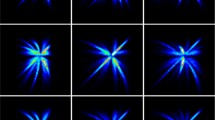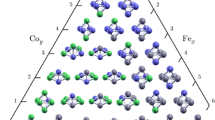Abstract
An exhaustive study of the structural and magnetic properties of Fe7−n Pt n with n = 0, 1, 2, …7, bimetallic clusters is presented. Based on ab initio density functional theory that includes spin-orbit coupling (SOC) and graph theory, the ground state geometry, the local chemical order, and the orbital and spin magnetic moments are calculated. We show how the systems evolves from the 3-d Fe to the quasi-planar Pt clusters. These calculations show that SOC are necessary to describe correctly the composition dependence of the binding energy of these nanoalloys. We observe that the ground state geometries on the Fe rich side resemble the fcc structure adopted by bulk samples. Furthermore, we observe how the spin and orbital magnetic moments depend on the chemical concentration and chemical order. Based on these results, we estimated the magnetic anisotropy energy and found that the largest values correspond to some of the most symmetric structures, Fe5Pt2 and FePt6. To determine the degree of non-collinearity, we define an index that shows that in FePt6 the total magnetic moments, on each atom, are the less collinear.





Similar content being viewed by others
References
Alonso JA (2000) Electronic and atomic structure, and magnetism of transition-metal clusters. Chem Rev 100:637–77
Alvarado-Leyva PG, Aguilera-Granja F, Garcí a-Fuente A, Vega A (2014) Spin-orbit effects on the structural, homotop, and magnetic configurations in small pure and Fe-doped Pt clusters. J Nanopart Res 16:2222(11)
Bacon GE, Crangle J (1953) Chemical and magnetic order in platinum-rich Pt+Fe alloys. Proc Roy Soc 272:387–405
Baletto F, Ferrando R (2005) Structural properties of nanoclusters: energetic, thermodynamic, and kinetic effects. Rev Mod Phys 77:371–423
Bhattacharyya K, Majumder C (2007) Growth pattern and bonding trends in Pt n (n = 2 − 13) clusters: theoretical investigation based on first principle calculations. Chem Phys- Lett 446:374–9
Billas IML, Becker JK, Chatelain A, de Heer WA (1993) Magnetic moments of iron clusters with 25 to 700 atoms and their dependence on temperature. Phys Rev Lett 71:4067–70
Cable JW, Wollan EO, Koehler WC (1965) Distribution of magnetic moments in Pd – 3d and Ni – 3. Phys Rev 138:755–759
Cadeville MC, Morán-López JL (1987) Magnetism and spatial order in transition metal alloys: experimental and theoretical aspects. Phys Rep 153:331–99
Castro M (1997) The role of Jahn-Teller distortions on the structural, binding, and magnetic properties of small Fe n clusters. Int J Quantum Chem 64:223–230
Cervantes-Salguero K, Seminario JM (2012) Structure and energetics of small iron clusters. J Mol Model 18:4043–52
Chen A, Holt-Hindle P (2010) Platinum-based nanostructured materials: synthesis, properties, and applications. Chem Rev 110:3767–804
Chittari BL, Kumar V (2015) Atomic structure, alloying behavior, and magnetism in small Fe-Pt clusters. Phys Rev B 92(17):125442
Crippen GM, Havel TF (1988) Distance geometry and molecular conformation. Wiley, p 12
Dahmani CE, Cadeville MC, Sanchez JM, Morán-López JL (1985) Ni-Pt phase diagram: experiment and theory. Phys Rev Lett 55:1208–11
Ferrando R, Jellinek J, Johnston RL (2008) Nanoalloys: from theory to applications of alloy clusters and nanoparticles. Chem Rev 108:845–910
Fredriksson P, Sundman B (2001) A thermodynamic assessment of the Fe-Pt system. Calphad 25:535–48
Gruner ME, Rollmann G, Entel P, Farle M (2008) Multiply twinned morphologies of FePt and CoPt nanoparticles, Phys. Phys Rev Lett 100(4):087203
Heiles S, Johnston R L (2013) Global optimization of clusters using electronic structure methods. Int J Quantum Chem 113:2091–2109
Hobbs D, Kresse G, Hafner J (2000) Fully unconstrained non-collinear magnetism within the projector augmented-wave method. Phys Rev B 62:11556–70
Karoui S, Amara H, Legrand B, Ducastelle F (2013) Magnetism: the driving force of order in CoPt, a first-principles study. J Phys Cond Matter 25(6):056005
Kohler C, Seifert G, Frauenheim T (2005) Density functional based calculations for Fen (n32). Chem Phys 309 :23–31
Krén E, Szabó P (1965) Magnetic moments in the ordered Fe2.8Pt1.2 alloy. Solid State Commun 3:371–372
Kresse G, Furthmüller J (1996) Efficient iterative schemes for ab initio total-energy calculations using a plane-wave basis set. Phys Rev B 54:11169–86
Kresse G, Hafner J (1993) Ab initio molecular dynamics for liquid metals. Phys Rev B 47:558–61
Kresse G, Hafner J (1994) Ab initio molecular-dynamics simulation of the liquid-metal-amorphous-semiconductor transition in germanium. Phys Rev B 49:14251–269
Kresse G, Joubert D (1999) From ultrasoft pseudopotencials to the projector augmented-wave method. Phys Rev B 59:175875
Kumar V, Kawazoe Y (2008) Evolution of atomic and electronic structure of Pt clusters; Planar, layered, pyramidal, cage, cubic, and octahedral growth. Phys Rev B 77 :205418(10), and references therein
Langenberg A, Hirsch K, Lawicki A, Zamudio-Bayer V, Niemeyer M, Chimieala P, Langbehn P, Terasaki A, v. Isendorf B, Lau JT (2014) Spin and orbital magnetic moments of size-selected iron, cobalt, and nickel clusters. Phys Rev B 90:184420(14)
Liu X, Bauer M, Bertagnolli H, Roduner E, van Slageren J, Phillipp F (2006) Structure and Magnetization of small monodisperse platinum clusters. Phys Rev Lett 97 :253401(4)
Massalski ThB (2007) Binary alloy phase diagrams, vol 2, 2nd edn. ASM International 2007, pp 1752–1756
Mejía-López J, Romero AH, García ME, Morán-López JL (2006) Noncollinear magnetism, spin frustration and magnetic nanodomains in small Mn n clusters. Phys Rev B 74:140405(6)
Mejía-López J, Romero AH, García ME, Morán-López JL (2008) Understanding the elusive magnetic behavior of manganese clusters. Phys Rev B 78:134405(8)
Meyer J, Tombers M, v. Wüllen C, Niedner-Schattenburg G, Peredkof S, Eberhardt W, Neeb M, Palutke S, Martins M, Wurth W (2015) The spin and orbital contributions to the total magnetic moments of free Fe, Co, and Ni clusters. J Chem Phys 143:104302(12)
Montejano-Carrizales JM, Aguilera-Granja F, Goyheneux C, Pierron-Bohnes V, Morán-López JL (2014) Structural, electronic, and magnetic properties of Co n Pt M − n for M = 13,19 and 55, from first principles. J Mag Mag Mat 355:215–224
Moré J, Wu Z (1999) Distance geometry optimization for protein structures. J Global Optim 15:219–234
Mucherino A, Lavor C, Liberti L, Maculan N (eds) (2013) Distance geometry - theory, methods, and applications. Springer Science & Business Media, New York
Muñoz F, Romero AH, Mejía-López J, Morán-López JL (2012) First-principles theoretical investigation of monoatomic and dimer Mn adsorption on noble metal (111) surfaces. Phys Rev B 85:115417(14)
Niemeyer M, Hirsch K, Zamudio-Bayer V, Langenberg A, Vogel M, Kossik M, Ebrecht C, Eagashira K, Terasaki A, Möller T, V. Isendorf B, Lau JT (2012) Spin coupling and orbital angular momentum quenching in free Iron clusters. Phys Rev Lett 108:057201(5)
Payne FW, Jiang W, Bloomfield LA (2006) Magnetism and magnetic isomers in free chromium clusters. Phys Rev Lett 97:193401(4)
Perdew JP, Burke K, Ernzerhof M (1996) Generalized gradient approximation made simple. Phys Rev Lett 77 :3865–68
Pierron-Bohnes V, Mirebeau I, Balanzat E, Cadeville MC (1984) Evidence of a coupling between magnetic and chemical interactions in FeV alloys: metallurgical aspects. J Phys F Met Phys 14:197–210
Rodríguez-Alba R, Acosta-Ortiz SE, Morán-López JL (2015) Ordered states in binary alloys with one magnetic component: a binomial description. Solid State Commun 218:6–9
Rodríguez-Kessler PL, Ricardo-Chávez JL (2015) Structure of FePt clusters and their interactions with the O2 molecule. Chem Phys Lett 622:34–41
Sanchez JM, Morán-López JL, Leroux C, Cadeville MC (1988) Magnetic properties and chemical ordering in Co-Pt. J Phys C 21:L1091-6
Sun S, Murray CB, Weller D, Folks L, Mose A (2000) Monodisperse FePt nanoparticles and ferromagnetic FePt nanocrystal supperlattices. Science 287:1989–1992
Truhlar DG (2001) Potential energy surfaces, encyclopedia of physical science and technology, vol 13, 3rd edn. Academic Press, New York, pp 9–17
Wang Y, George TF, Lindsay DM, Beri AC (1987) The Hückel model for small metal clusters I. Geometry, stability, and relationship to graph theory. J Chem Phys 86:3493–9
Wang J-P (2008) FePt magnetic nanoparticles and their assembly for future magnetic media. IEEE 96:1847–1863
Weller D, Moser A, Folks L, Best ME, Lee W, Toney MF, Schwickert M, Thiele JU, Doemer MF (2000) High K u materials approach to 100 Gbits/in2. IEEE Trans Magn 36:10–15
Xiao L, Wang L (2004) Structures of platinum clusters: planar or spherical? J Phys Chem A 108:8605–14
Yamamoto Y, Miura T, Nakae Y, Teranishi T, Miyake M, Hori H (2003) Magnetic properties of the nobel metal nanoparticles protected by polymer. Physica (Amsterdam) 329B–333B:1183–4
Acknowledgments
Computing resources provided by Texas Advanced Computing Center (University of Texas at Austin, USA) and Laboratorio Nacional de Supercómputo (Benemérita Universidad Autónoma de Puebla, Puebla, Mexico) are gratefully acknowledged. J. L. R.-C. acknowledges support from Fondo Ciencia Básica CONACyT (Mexico) through grant number 86342. One of us A.P. P-T acknowledges the Mexican Council of Science (CONACYT) for a doctoral fellowship.
Author information
Authors and Affiliations
Corresponding author
Rights and permissions
About this article
Cite this article
Ponce-Tadeo, A.P., Morán-López, J.L. & Ricardo-Chavez, J.L. Structural and magnetic properties of Fe7−n Pt n with n = 0, 1, 2, . . . 7, bimetallic clusters. J Nanopart Res 18, 330 (2016). https://doi.org/10.1007/s11051-016-3629-1
Received:
Accepted:
Published:
DOI: https://doi.org/10.1007/s11051-016-3629-1




